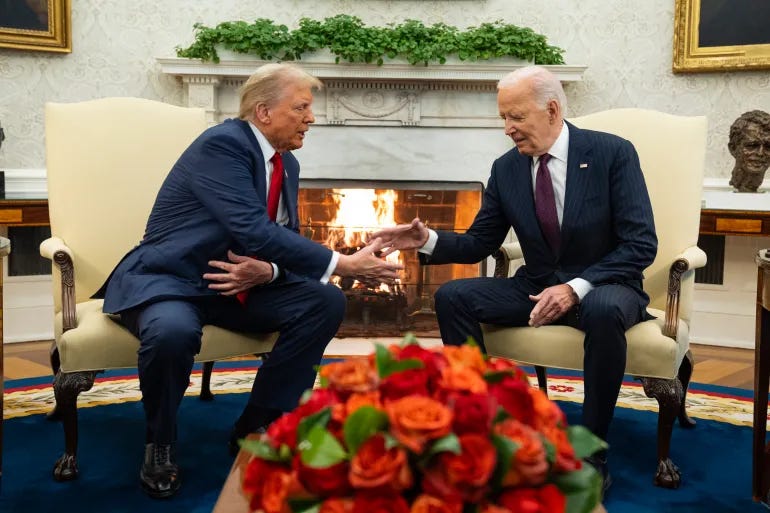How Will Trump Shape – and Possibly Shift – Presidential Power in His Second Term?
Experts warn that Trump's second presidency could further expand executive authority, reshaping the presidency in ways that may defy constitutional checks and balances.
As President-elect Donald Trump prepares to take office once again, only five days remain before he embarks on a second term that promises to test the boundaries of presidential power. After a surprising political comeback following his 2020 defeat, Trump’s next four years could bring significant changes to the office of the president — an office that has steadily grown in power over the decades, despite its constitutional role as a check on the legislative and judicial branches.
Trump’s history of asserting expansive claims of presidential authority, coupled with his polarizing leadership style, has caused alarm among experts who fear the future of the presidency under his direction. Marjorie Cohn, professor emerita at the Thomas Jefferson School of Law, argues that his second term could fundamentally alter how federal agencies operate in crucial sectors like health, safety, climate, and labor. She also warned that Trump’s personal vendettas and rivalries could blur the lines of what law enforcement and intelligence agencies are legally authorized to do.
“Trump has called for televised military tribunals to jail critics, including Joe Biden, Kamala Harris, Mitch McConnell, Chuck Schumer, Liz Cheney, and Mike Pence,” Cohn said. “He may even deploy the military to target peaceful protesters.”
A Trend of Expanding Presidential Power
While predicting Trump’s actions is challenging due to his unpredictability, experts like Mitchel Sollenberger, a professor at the University of Michigan-Dearborn, believe his second term could reveal the true extent of his ambition for power. Sollenberger noted that modern presidents have long expanded executive authority, and Trump’s first term was no exception.
However, he cautioned that there are limits to this trend. Sollenberger pointed to the fallout from President Richard Nixon’s abuse of power in the 1970s as an example of the backlash that can arise when a president exceeds constitutional bounds. Nixon’s secret bombing campaign during the Vietnam War and wiretapping of political opponents led to widespread outrage, culminating in his resignation in 1974.
Despite such setbacks, subsequent presidents, including George W. Bush, have found ways to expand the reach of the presidency. The Authorization for Use of Military Force (AUMF), passed in 2001, allowed Bush to pursue military action under the guise of the "war on terror," bypassing Congress’s authority to declare war.
The "Give-and-Take" of Power
As Trump enters office with a Republican-controlled House, Senate, and a conservative majority on the Supreme Court, experts suggest the balance of power between the president, Congress, and the judiciary will be pivotal in shaping the extent of presidential authority.
Recent comments by Trump, including references to the 2024 election as a "final battle" and the idea that he would be a dictator "only on day one," have fueled concerns about his approach to governance. Critics, including Vice President Kamala Harris, have labeled him an "autocrat" due to his admiration for strongman tactics.
Trump’s recent comments and actions seem to signal his intent to test the limits of presidential power, especially in how he deals with political opponents and the media. His controversial pick for FBI Director, Kash Patel, has suggested using the office to prosecute journalists, while his administration has already begun staffing key positions with loyalists who echo his desire for aggressive action.
Project 2025 and Unchecked Power
One of the most alarming developments is the rise of “policy czars” – unelected officials who hold significant influence over areas like border security and artificial intelligence. Several of these individuals are associated with Project 2025, an ultraconservative policy initiative developed by the Heritage Foundation that seeks to dramatically increase presidential power. Critics argue that the project’s goals, including the weaponization of the Department of Justice and the politicization of civil servants, would dismantle checks and balances in the federal government.
An analysis by the Center for American Progress warned that Project 2025 could grant the president unchecked power, effectively allowing the executive branch to control Americans' lives. The initiative outlines a vision for a White House that would hold near-total control over the federal bureaucracy, sidelining Congress and the judiciary.
Presidential Immunity and the Legal Landscape
Trump’s second term could also be shaped by legal decisions that influence his ability to push boundaries. The Supreme Court’s recent ruling granting presidents broad immunity for their official actions could embolden Trump as he faces ongoing criminal investigations. Some critics argue that this immunity could allow him to avoid accountability for actions taken during the January 6th insurrection, which remains a point of contention among legal experts.
Trump’s actions during the Capitol riot, including attempts to overturn the 2020 election results, highlight the broader question of how far presidents can go in exercising their power before crossing constitutional lines. Although Trump has faced criminal charges, including accusations of election interference, many of these cases have either been dropped or stalled, raising questions about the true limits of presidential immunity and authority.
As Trump’s second term begins, the nation will be closely watching how he approaches the presidency and whether he will test, or redefine, the limits of executive power in ways that could reshape American democracy for years to come.


